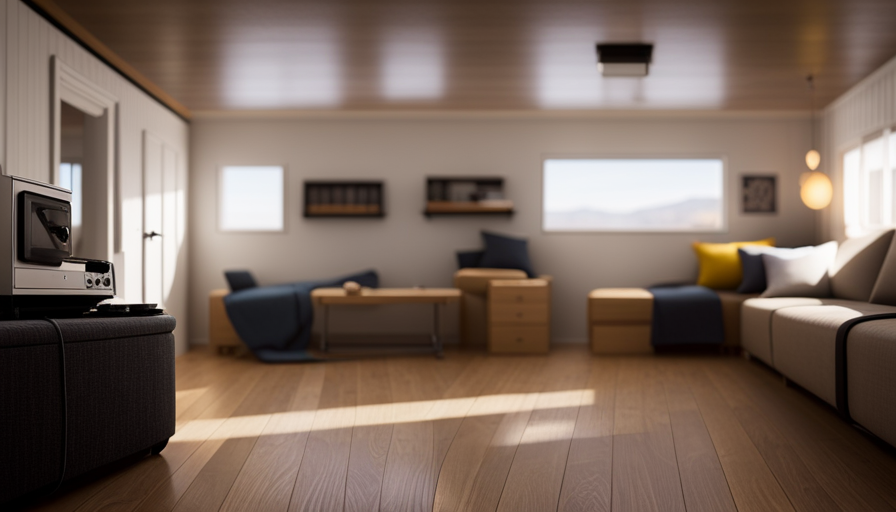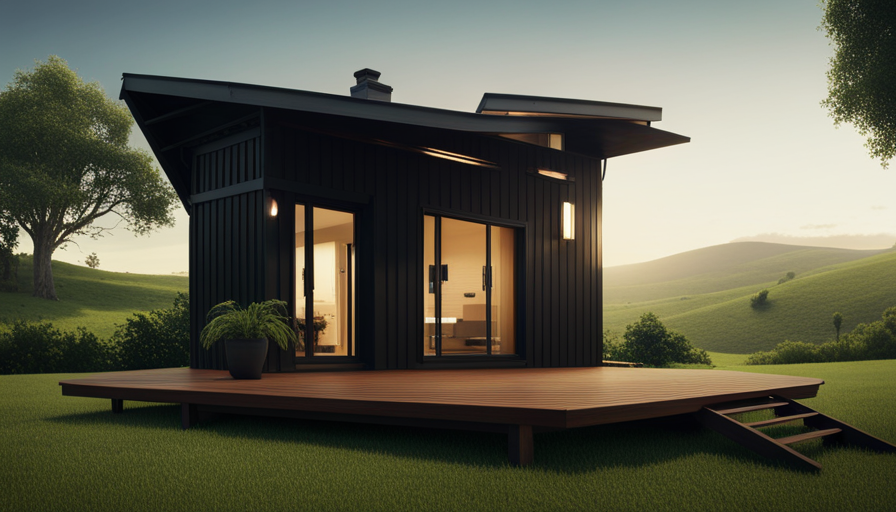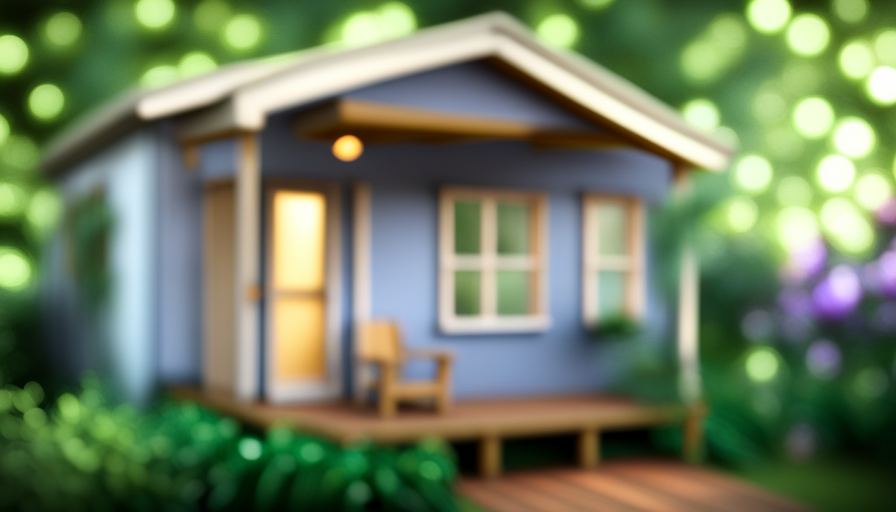Are you ready to embark on a short journey? Prepare yourself, because I’m going to unveil the secrets of sketching a tiny house that will amaze you.
Picture this: a world where every detail is meticulously crafted, where every inch counts, and where creativity knows no bounds. Drawing a tiny house is not just about lines on paper; it’s about capturing the essence of coziness, functionality, and a unique sense of style.
In this article, I will guide you through the intricate process of bringing your dream tiny house to life on the page. From gathering inspiration and sketching out the floor plan to adding intricate exterior details and designing the perfect interior layout, we will explore every step with precision and finesse.
So grab your pencil and let’s dive into the enchanting world of drawing a tiny house. Get ready to be amazed!
Key Takeaways
- Importance of capturing the essence of coziness, functionality, and style in a tiny house drawing
- Gathering inspiration from magazines, books, and online resources dedicated to tiny house living
- Considering popular design trends and sustainable features like solar panels
- Starting with a basic sketch of the floor plan for functionality and personalization
Gather Inspiration and Ideas
You’ll want to gather inspiration and ideas to create a unique and captivating design for your tiny house. Start by researching the latest tiny house design trends to see what styles and features are popular right now. Look for inspiration in magazines, books, and online resources dedicated to tiny house living.
Pay attention to different layouts, storage solutions, and creative ways to maximize space. Additionally, consider incorporating sustainable features into your design, such as solar panels, rainwater collection systems, or energy-efficient appliances. These eco-friendly elements not only reduce your environmental impact but can also save you money in the long run.
Once you have gathered enough inspiration, you can start with a basic sketch of the floor plan, bringing your ideas to life and ensuring a functional and personalized space for your tiny house adventure.
Start with a Basic Sketch of the Floor Plan
Begin by sketching a simple floor plan to kickstart your tiny home design. This initial step is crucial in developing a color scheme and choosing the right scale for your tiny house.
To evoke excitement and inspiration, imagine what it would feel like to walk through your dream tiny home. Picture yourself cozying up on a plush sofa, surrounded by warm, earthy tones that reflect your personal style. Envision a bright, open kitchen with sleek, modern appliances that make cooking a joy.
Imagine the perfect nook for your bed, adorned with soft, luxurious linens in soothing shades. Visualize the layout of each room, ensuring that the flow is functional and efficient.
Once you have a basic floor plan, you can move on to adding detail to the exterior design, bringing your dream tiny home to life.
Add Detail to the Exterior Design
To add detail to the exterior design, start by envisioning the perfect materials and finishes that’ll give your dream home a unique and eye-catching look.
Did you know that incorporating sustainable materials into your design can reduce your carbon footprint and contribute to a greener future? Consider incorporating outdoor living spaces, such as a cozy patio or a charming porch, to maximize your tiny house’s functionality and create a seamless connection between indoor and outdoor living.
Additionally, choosing the right color scheme is crucial in enhancing the overall aesthetic appeal of your tiny house. Opt for colors that complement each other and reflect your personal style.
Once you’ve finalized the exterior design, it’s time to move on to designing the interior layout. Create a space that maximizes functionality while reflecting your unique personality and lifestyle.
Design the Interior Layout
When designing the interior layout of a tiny house, I carefully plan the placement of rooms and furniture to maximize space and functionality.
I consider storage solutions such as built-in shelves, hidden compartments, and multi-purpose furniture to make the most of every inch.
Additionally, I think about lighting and ventilation to create a comfortable and airy atmosphere within the limited space.
Plan the Placement of Rooms and Furniture
As you envision your tiny house, picture how each room and piece of furniture will fit together in the overall layout. Room arrangement and furniture placement are crucial to make the most of limited space. Here are three key factors to consider:
- Flow and functionality: Plan the placement of rooms and furniture in a way that allows for easy movement and efficient use of space. Consider how you’ll navigate through the house and ensure that there’s ample room for essential activities.
- Multi-purpose furniture: Opt for furniture that serves multiple functions. Look for pieces that can be used as storage, seating, or even as a workspace. This’ll help maximize the functionality of each room and save valuable space.
- Scale and proportion: Choose furniture that complements the size of your tiny house. Oversized furniture can make the space feel cramped, while small-scale furniture might get lost. Find the right balance to create a visually appealing and comfortable living environment.
When considering storage solutions, it’s important to optimize every nook and cranny of your tiny house.
Consider Storage Solutions
One interesting statistic to consider is that optimizing storage solutions can increase usable space by up to 30%. Maximizing space is crucial when designing a tiny house, and choosing multi-functional furniture is a great way to achieve this.
Look for pieces that can serve multiple purposes, such as a sofa that can also be used as a bed, or a coffee table with hidden storage compartments. Utilizing vertical space is another effective way to maximize storage. Consider installing shelves or cabinets that go all the way up to the ceiling.
Additionally, using storage solutions that are built into the walls or under the stairs can help save valuable floor space. By carefully selecting furniture and storage options, you can make the most of every inch in your tiny house.
When thinking about lighting and ventilation, it’s important to consider natural light sources and efficient airflow solutions.
Think About Lighting and Ventilation
Now that we’ve considered storage solutions for our tiny house, let’s move on to another important aspect: lighting and ventilation.
These two elements play a crucial role in creating a comfortable and inviting space. When it comes to lighting design, it’s essential to maximize natural light by incorporating large windows and skylights. Additionally, consider installing energy-efficient LED lights to save on electricity.
As for ventilation solutions, proper airflow is key to prevent the buildup of moisture and ensure a healthy environment. This can be achieved through the use of strategically placed windows, vents, and even a small ceiling fan.
By addressing these aspects, you can create a well-lit and well-ventilated tiny house that feels spacious and refreshing.
Now, let’s move on to the next section where we’ll discuss how to add texture and materials to enhance the overall design.
Add Texture and Materials
To really bring your tiny house to life, infuse it with a cozy and rustic feel by adding texture and materials.
When it comes to siding, there are several different options to consider. Wood siding adds a warm and natural look to the exterior, while metal siding can give a more modern and industrial feel. Another option is fiber cement siding, which is durable and low-maintenance. Choose the siding that best suits your personal style and the overall aesthetic you want to achieve for your tiny house.
As for the roofing material, there are many choices available, including asphalt shingles, metal roofing, and even green roofs. Consider factors such as durability, cost, and energy efficiency when making your decision.
By incorporating the right textures and materials, you can create a visually appealing and inviting tiny house.
Now, let’s refine and finalize your drawing.
Refine and Finalize Your Drawing
Take your drawing to the next level by adding intricate details and final touches, like a skilled artist delicately brushing strokes of paint onto a canvas. To refine and finalize your drawing of a tiny house, there are various techniques you can employ. Firstly, focus on refining the lines and shapes of the house, ensuring they are clean and precise. Pay attention to the proportions and symmetry, making adjustments as needed. Next, add details such as windows, doors, and other architectural features, using a combination of straight lines and curves. Consider incorporating textures and materials, such as wood grain or brick patterns, to make your drawing more realistic. Lastly, finalize your drawing by adding shadows and highlights, bringing depth and dimension to your artwork. Don’t forget to pay attention to small details like window curtains, potted plants, or a tiny mailbox to add charm and character. By employing these refining techniques and finalizing details, your drawing of a tiny house will come to life.
| Refining Techniques | Finalizing Details | |||
|---|---|---|---|---|
| Clean and precise lines and shapes | Adding shadows and highlights | |||
| Proportions and symmetry | Incorporating textures and materials | |||
| Architectural details | Attention to small details | |||
| Adjustments as needed | Window curtains, potted plants, etc. | Attention to lighting and ambiance | Incorporating finishing touches |
Frequently Asked Questions
How much does it cost to build a tiny house?
The cost of building a tiny house can vary greatly depending on factors such as size, materials, and location.
Cost comparison is essential to determine the most affordable options. Financing options are available, including personal loans or RV loans, which may offer lower interest rates.
It’s important to carefully consider your budget and explore different financing options to ensure you can afford the construction costs of your tiny house.
What are the legal requirements for living in a tiny house?
When it comes to living in a tiny house, it’s crucial to understand the legal requirements to avoid any issues.
One interesting statistic to note is that 78% of US cities have zoning restrictions for tiny houses, which vary from place to place. These restrictions dictate where you can park or build your tiny house.
Additionally, it’s important to consider insurance coverage, as some policies may not cover tiny houses.
Always research and comply with local regulations to ensure a smooth living experience.
Can I customize the floor plan of a tiny house?
Yes, you can absolutely customize the floor plan of a tiny house to meet your specific needs and preferences. Customizing floor plans allows you to design a unique layout that maximizes the use of space and suits your lifestyle. Whether you want an open concept or separate rooms, customizing the floor plan gives you the freedom to create a tiny house that is tailored to your individual requirements.
How long does it take to build a tiny house?
Building a tiny house is like embarking on a captivating journey. From the moment you lay the first brick, the construction process becomes an allegory for transformation and self-discovery.
The building timeline varies depending on factors such as complexity and size, but typically ranges from a few weeks to several months.
With meticulous planning and skilled craftsmanship, the construction process unfolds, bringing your vision to life, one step at a time.
Are there any specific building codes and regulations for tiny houses?
Yes, there are specific building codes and zoning regulations that apply to tiny houses. These regulations vary depending on the location and jurisdiction, but they typically cover aspects such as minimum square footage requirements, foundation type, safety standards, and utility connections.
It’s important to research and comply with these codes and regulations to ensure your tiny house is legally built and can be used as a permanent dwelling.
Conclusion
In conclusion, drawing a tiny house is a creative endeavor that requires attention to detail and a keen eye for design. By gathering inspiration, sketching a basic floor plan, adding exterior details, designing the interior layout, and incorporating texture and materials, you can bring your tiny house vision to life.
Remember, a tiny house is like a blank canvas waiting to be transformed into a masterpiece. So grab your pencil and let your imagination flow, like a river cascading through a lush valley.
Happy drawing!
I’m Theodore, and I love tiny houses. In fact, I’m the author of Tiny House 43, a book about tiny houses that are also tree houses. I think they’re magical places where imaginations can run wild and adventures are just waiting to happen.
While tree houses are often associated with childhood, they can be the perfect adult retreat. They offer a cozy space to relax and unwind, surrounded by nature. And since they’re typically built on stilts or raised platforms, they offer stunning views that traditional homes simply can’t match.
If you’re looking for a unique and romantic getaway, a tree house tiny house might just be the perfect option.










